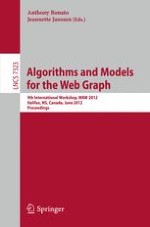2012 | Buch
Algorithms and Models for the Web Graph
9th International Workshop, WAW 2012, Halifax, NS, Canada, June 22-23, 2012. Proceedings
herausgegeben von: Anthony Bonato, Jeannette Janssen
Verlag: Springer Berlin Heidelberg
Buchreihe : Lecture Notes in Computer Science
